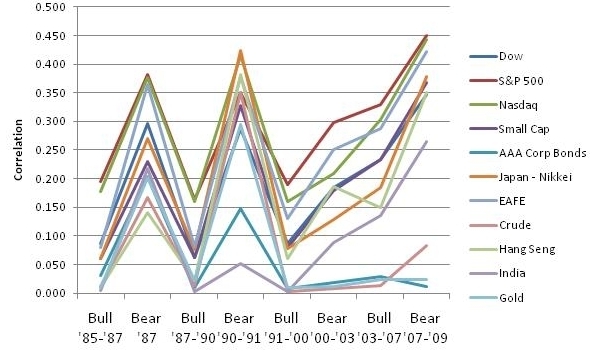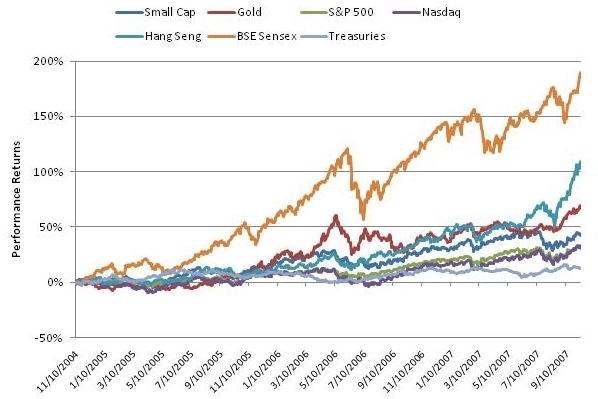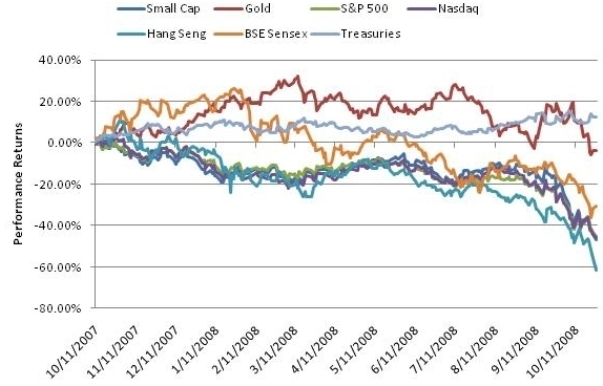
For Immediate Release
January 5, 2011
Contact:
Kirk Chisholm, Principal, NUA Advisors, LLC
617.372.9033
E-mail: laurie@nuaadvisors.com
kirk@nuaadvisors.com
Web Site: http://www.nuadvisors.com
Study of Traditional Asset Correlation in the New Millennium Finds Investing in Non-Widely Held Assets Best Way to Achieve True Diversification
Study by Kirk Chisholm of NUA Advisors examined traditional asset correlation during both bull and bear markets
BOSTON - Markowitzâs Modern Portfolio Theory shows that a diversified portfolio of low-correlation assets provides an optimal risk/return relationship. Investors traditionally invest in a mix of assets such as stocks, bonds, and mutual funds (âtraditional assetsâ), believing that they are forming a diversified, low-correlation portfolio by doing so.However, our research shows that diversification among several traditional asset classes is not effective during bear markets because those assets become highly correlated, more so than they do during bull markets. Additionally, over the past decade, traditional assets have become much more correlated, suggesting traditional diversification is losing its effectiveness.
We have examined the correlation of returns for 10 traditional assets during bull and bear markets over the past 25 years. Using historical regression analysis, we examined the coefficient of determination (R-squared) between each pair of assets. The R-squared reflects how much of one assetâs price change is determined by another assetâs change.
For example, if assets A and B have an R-squared of 0.6, 60% of Aâs movement is determined by B. Ideally, investors want the lowest R-squared possible among assets in their portfolios. This will allow said assets to move more independently of one another, thus providing proper diversification.
We have identified the following time periods as bull markets:
- January 1st, 1985 â October 19th, 1987
- December 4th, 1987 â July 13th, 1990
- January 11th, 1991 â September 1st, 2000
- March 7th, 2003 â October 12, 2007
- October 19th, 1987 â December 4th, 1987
- July 13th, 1990 â January 11th, 1991
- September 1st, 2000 â March 7th, 2003
- October 12th, 2007 â March 9th, 2009
US Equity
NASDAQ Composite
S&P 500
Dow Jones Industrial
Small Cap US Equity
International Equity
EAFE Index
Hang Seng Index
Nikkei 225
BSE Sensex
Commodities
Gold
Crude Oil
DJ-AIG Commodity Index
Debt
AAA Corporate Bonds
High Yield Bonds
We created a correlation matrix among all asset classes for each bull and bear market and then took the average correlation between each asset class and all the others. This data results in an average correlation among all assets for each market since 1985, as shown in Chart 1 (Bull and Bear Asset Correlation).
Chart 1:
 Our data analysis provided two conclusions:
Our data analysis provided two conclusions:- In general, there is significantly more correlation among asset classes during bear markets compared to bull markets.
- The level of correlation between traditional asset classes has increased dramatically in the past decade compared to the prior 15 years.
Chart2:
 What does this mean for investors?
What does this mean for investors?Diversification is a great risk management tool during bull markets due to its ability to reduce volatility, smooth portfolio returns, and help mitigate individual asset risk. This means that in a properly diversified portfolio, some securities will outperform the market, some will underperform, but overall the portfolio should provide more consistent returns as opposed to the sometimes wild fluctuations inherent in any one asset. The growth in index funds or ETFs is an example of this interest in proper diversification. When investment is restricted to an index, it helps eliminate individual security risk. While proper diversification is beneficial, over-diversification may not add value and may even hinder performance according to Markowitzâs Modern Portfolio Theory.
During Bear markets, many assets tend to correlate more highly and can defeat the general purpose of the strategy. There are a few reasons for this, but the simplest explanation is that asset prices increase primarily on fundamentals. For example, countries with rapidly expanding economies will see their stock indices grow faster, and commodities with especially high demand will see their prices increase more than others. However during bear markets, financial institutions, mutual funds, hedge funds, and pension funds liquidate holdings to meet investor redemptions and other liquidity needs, rather than selling for fundamental reasons, which can cause asset prices to drop across the board. This activity can trigger stop losses and other risk mitigation methods causing further selling (e.g., creating waterfall price drops that can cause portfolio managers to act in ways they did not intend.) In 2008, the liquidations made the selloff worse by the amount of leverage being used by financial institutions and hedge funds. When portfolio managers must engage in major liquidations, they tend to close out their more favored assets first since these can provide the easiest way to raise cash. Although this may be counterintuitive, when liquidity is the primary concern, everything else takes a backseat to this goal.
As shown in Chart 2 (Bull Market: November 2004 to September 2007), diversification would provide total returns of nearly 70% in less than three years by forming an equally weighted portfolio of small cap, gold, S&P 500, Nasdaq, Hang Seng, BSE Sensex, and Treasuries. Although treasuries grew by just 12.6% in that time, developing countries provided growth of over 100%, demonstrating that diversification would have been very effective during this particular bull market.
Conversely, as seen in Chart 3 (Bear Market: October 2007 to October 2008) in just over one year following the marketsâ peak, the same equally weighted portfolio would return -31.6%. Treasuries again returned just under 13%, but the collapse of everything else caused a net loss. For the most passive investors who did not rebalance their portfolios at the market peak to an equal weighting, the loss would be -33.4%.
 The other conclusion drawn from our research is that correlation between these referenced assets has increased over time. Prior to 2000, bull markets had an average correlation of between .062 and .074, and bear markets ranged between .259 and .310. This means that the correlation between these traditional assets is about 2.5 times higher during bear markets compared with bull markets.
The other conclusion drawn from our research is that correlation between these referenced assets has increased over time. Prior to 2000, bull markets had an average correlation of between .062 and .074, and bear markets ranged between .259 and .310. This means that the correlation between these traditional assets is about 2.5 times higher during bear markets compared with bull markets. After 2000, there was a material change in asset correlation. The bear market of 2000-03 had correlation of just 0.142, about half that of previous bear markets. During the bull market that followed, the correlation was higher than that of the preceding bear market, with average correlation reading 0.175. During the most recent bear market, the correlation was the second highest of any market, reaching .286.
Our conclusion is that as the world becomes smaller, correlations should be expected to increase. As people invest in a greater number of markets in search for low-correlation assets, we expect these sought after markets to become more correlated as a result of increased interest. Over time, investors have gained greater access to international markets, commodities, and other assets which were difficult to invest in previously. So when investors liquidate entire portfolios, they are likely to be selling in many different markets and most likely the more prized assets in search of liquidity. When investors buy back into the market, they will choose more carefully than when selling.
Based on this information, we have concluded that investing in non-widely held assets is the best way to achieve true diversification. Non-widely held assets that continue to spin off cash flows during all markets are the most desirable. By investing in off-exchange or non-widely held assets that provide stable cash flows, investors may be able to shield a portion of their portfolio from the broad downturns that are likely to decimate a portfolio of highly correlated traditional assets.
About the author:
 Kirk Chisholm, Wealth Manager and Principal of NUA Advisors, LLC (www.nuaadvisors.com) provides wealth management services to individuals, executives, and entrepreneurs. Mr. Chisholm received a BA degree in Economics from Trinity College in Hartford, Conn. He has worked in the private client group of both UBS PaineWebber and Smith Barney. NUA Advisors, LLC, full-service wealth management firm, was created to fulfill the need for true diversification of low-correlation assets. He can be contacted at kirk@nuaadvisors.com.
Kirk Chisholm, Wealth Manager and Principal of NUA Advisors, LLC (www.nuaadvisors.com) provides wealth management services to individuals, executives, and entrepreneurs. Mr. Chisholm received a BA degree in Economics from Trinity College in Hartford, Conn. He has worked in the private client group of both UBS PaineWebber and Smith Barney. NUA Advisors, LLC, full-service wealth management firm, was created to fulfill the need for true diversification of low-correlation assets. He can be contacted at kirk@nuaadvisors.com.About NUA Advisors
NUA Advisors, LLC (NUA), an independent Registered Investment Advisory Firm is bridging the gap between traditional and non-traditional investing. NUA is unique in that they have an extensive understanding of the regulatory and financial considerations involved in a SDRA. NUA and its representatives work with clients of all levels of income and sophistication levels to invest in alternative investments. NUA advises clients on traditional securities investments such as stocks, bonds, and mutual funds as well as advising clients on non-traditional investmentsâsomething most banks, brokerage firms and other IRA sponsors wonât permit you to do. NUA Advisors has a value-oriented approach to investing, which integrates specialized investment experience with extensive resources.
Disclaimer: This article is intended solely for informational purposes only, and in no manner intended to solicit any product or service. The opinions in this article are exclusively of the uthor(s) and may or may not reflect all those who are mployed, either directly or indirectly or affiliated with NUA Advisors, LLC. NUA Advisors, LLC and Winlock Investment Alliance are unrelated and unaffiliated entities. Data for this article was used from the following sources: Bloomberg, The Federal Reserve, and the Investment Company Institute.
Here is more information about NUA Advisors
NOTE: Wolfe News Wire is an online source for news and information about noteworthy companies and organizations. We invite you to share this content and/or leave a comment. Background info and past news items from a specific organization can be found by clicking the side logos. For more info, please email info@wolfenews.com. Thank you!
©2015 Wolfe Public Relations. All Rights Reserved.






























